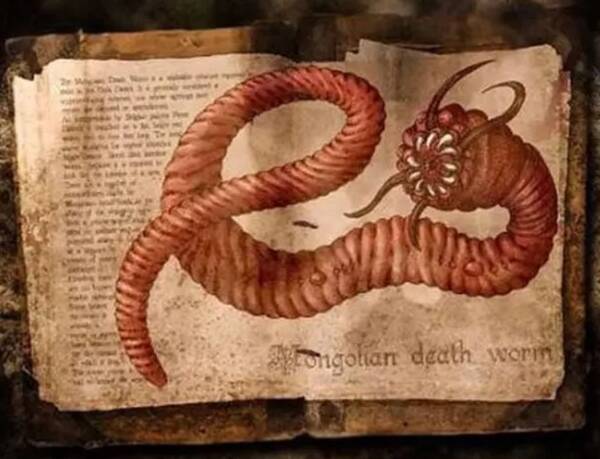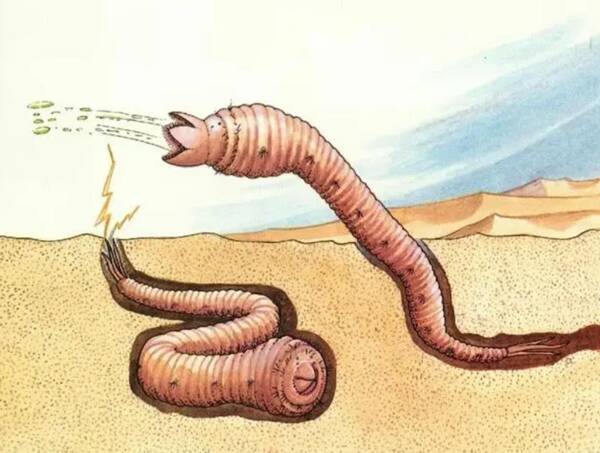Looking at the picture below, are you scared?
It is the legendary death worm that grows in the Mongolian desert. It has no eyes and a large mouth full of sharp teeth.

Death worms live in sand dunes. They dig a huge nest where they hide from the heat during the day and only come out at night. When they feel the vibrations on the surface of the yellow sand in their nests, they will quickly jump out of the ground and devour their prey.
In 1922, American explorer Roy Andrews first heard about the Mongolian death worm at a gathering of senior Mongolian officials. The person who told him the legend of the death worm was the then Prime Minister of Mongolia.
The Prime Minister told him that death worms are one meter long and their sharp teeth are their hunting weapons. They also have a secret weapon, which is that their bodies are full of poison.
In other legends, the death worm's venom can be sprayed from a distance, and it also releases powerful electric currents.
But the Prime Minister and Roy said that these are just people's exaggerations. The death worm is poisonous, but it cannot spray very far and does not discharge electricity. Although what he himself said about the death worm is also just a legend.
But Roy did not regard this as an ordinary conversation at an ordinary party. He recorded the death worm in detail in his book. Because of this, the story of death worms became more widely spread, and even became more and more mysterious.

Some people say that death worms are particularly active in the summer, especially when it is about to rain.
Some people say they have seen the death worm with their own eyes. When it moves under the dunes, they will see the winding undulations of the desert surface.
Some people say that death worms like to lay eggs inside camels.
Some even say that the death worm's venom can corrode metal.
In order to explore these mysteries, in 1990, an explorer named Ivan Matzkle organized a team to enter the Mongolian Gobi to search for the legendary death worm.
But after two years of searching, he finally came up empty-handed.
In 2005 and 2009, two reporters also entered the desert, but still found nothing.
Everyone can't help but wonder, is all this a lie by the Mongolian Prime Minister, just to tease those curious explorers?
Doubts remain doubts, but everyone still believes that there may be such a giant worm in the desert. After all, there are tigers in the mountains, whale sharks in the sea, and large predators in the desert.

This is also a traditional science fiction setting, with apex predators lurking under the dunes.
As a result, the classic science fiction novel "Dune" based on such a setting was born.
Tolkien, who created the fantasy world of Middle-earth, also had the image of death worms in his early creations.
But does the Mongolian Death Worm really exist to provide material for writers, or is it really just people's wild imagination?
Practically speaking, the death worm should not exist. Assuming it had existed, such an ancient creature would have become extinct long ago like the dinosaurs.
If humans had seen them, hunters would have killed them all. In addition to hunting, such giant insects pose an existential threat to humans.
For example, in some relatively isolated places on the earth, such as Australia, New Zealand, Madagascar, etc., there are some peculiar ecosystems.

Because these places are surrounded by the sea, mammals on existing land can reach them, and the only ones that can reach these lands are birds. Because there are no ferocious land beasts to hunt the birds, they can live carefree on these islands.
Without the need to fly to avoid hunting, the wings will be used less and less, so that they will gradually degrade. The bird that originally flew vigorously in the sky will become a flightless fat bird, just like the Dodo.
Without degenerating into flightless fat birds, they may become new predators in this ecosystem, replacing lions and tigers, such as Haast's giant eagle.
They can reach a height of 1 meter when standing, with eagle wings spread to a full length of 2.6-3.5 meters, and weigh 10 to 18 kilograms, which is much heavier than ordinary birds.
The main food of the Haast's giant eagle is the flightless fat birds on the island, also called moa. The largest ones can reach 3.6 meters in height and weigh 250 kilograms.
Being able to prey on such a huge moa, the strength of the Haast Giant Eagle cannot be underestimated. Think about it, they can kill even birds several meters high, which is simply more terrifying than the Mongolian death worm. If they target humans, humans will not be able to escape.

But why don't they hurt humans? What's more, no one has heard of this creature?
That's because they were killed by the first hunters to set foot on New Zealand 700 years ago. These hunters are the Maori in today's New Zealand, and the Maori are New Zealand's native fighting nation.
Not only the Haast's giant eagle, but also the moa were eaten by the Maori. However, Maori eat moa because of their need for food and clothing, while Haast's giant eagle is killed because it poses a threat to Maori's life safety.
Therefore, if the death worm really exists, why can't the Mongols, who are as fierce as the Maori, not be able to deal with it? After all, according to the settings, the Death Worm is much weaker than the Haast Eagle.
Moreover, death worms are annelids similar to earthworms. Generally speaking, they do not leave any skeleton fossils. If they ever existed in the world, there is no trace.
But don’t forget, they also have sharp teeth. If they had existed, even though they had no body skeleton fossils left, their tooth fossils might still be preserved. But according to modern exploration of death worms, there is not a trace of fossilized worm teeth left.

If there is an animal that is similar to a death worm, there is one, and it is the Bobbitt worm.
Bobbitt worms are 1 meter long on average, and the longest ones can grow up to 3 meters. They usually hide in the ocean sand and are also predatory. Their food is fish and shrimp. When hunting, Bobbitt bugs move very quickly and are very aggressive.
Cornwall Aquarium once had corals and small fish being eaten, but the staff searched for a long time but could not find the "fish killer". After finally moving the corals and small fish, they discovered that the fish were hidden in the sand in the tank. , hiding a bobbit worm.
However, modern science still lacks understanding of Bobbitt worms, except that their feeding methods are very similar to death worms.
animal tags: sandworm dune monster worm
We created this article in conjunction with AI technology, then made sure it was fact-checked and edited by a Animals Top editor.